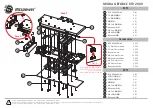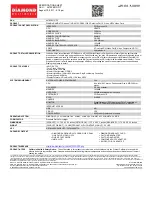
66
SoundExpression
F
fax mode
. The modem is in fax mode when,
through use of fax communications software,
it can send and receive faxes, print and
display fax files, convert files to fax-files, and
set certain fax-related features. Note: the
modulation protocol used by the modem in
fax mode is also different from the usual data
mode modulation.
flow control
. Compensates for the difference
between the rate at which data reaches a
device and the rate at which the device
processes and transmits. The two common
types of flow control are RTS/CTS signaling
(a hardware based method, employing an
electrical signal) and XON/XOFF (a software-
based method using standard ASCII control
characters to pause or resume transmission).
The \G command controls XON/XOFF flow
control.
full-duplex
. Two-way simultaneous
transmission between modems, which may
occur via a four-wire circuit on a leased line,
or with a two-wire connection when the
frequency bandwidth is divided into two
distinct channels, or when echo cancellation
is employed (e.g., Bell 103, 212, and V.22 use
frequency division, while V.32 uses echo
cancellation).
G
guard tone
. Guard tones are used in the
United Kingdom and other countries. This
requires that the modem transmit an 1800-Hz
tone after it sends an answer tone. The guard
tone is controlled by the &G command.
Guard tones are not used in the U.S.A.
H
half-duplex
. Signal flow in both directions,
but only one way at a time with each modem
alternating between send and receive.
Hayes-compatible
. Hayes Microcomputer
Products, Inc. developed the AT command set
which has become a de facto industry
standard. Hayes commands are always
initiated with an AT (attention code) prefix.
hook flash
. The dial modifier “!” causes the
modem to go on-hook (hang-up) for one-half
second. Also controlled by the ATH
command.
L
LAPM
. Link Access Protocol Modem. A V.42
ARQ type of error correction protocol where
LAPM may be activated with or without
V.42bis data compression.
leased line
. Also referred to as a private line.
A leased line is obtained from a
communications company (carrier) to
provide a transmission medium between two
points. The line consists of a permanent
dedicated circuit between two points, or to set
of previously arranged points. The cost of the
line is usually based on the distance between
locations. This is in contrast to switched or
dial-up lines, which can be connected to any
point on the network.
line modulation
. The means by which a
carrier is varied to represent a signal carrying
information. In a modem, the user’s digital
data is used to modulate the modem’s
transmitter’s carrier or carrier to allow the
digital signal to be carried over analog
facilities.
Содержание SE14SRS
Страница 1: ...1...
Страница 2: ...2 SoundExpression...
Страница 71: ...71...
Страница 72: ...72 SoundExpression PN 9476 Rev 1 0...







































